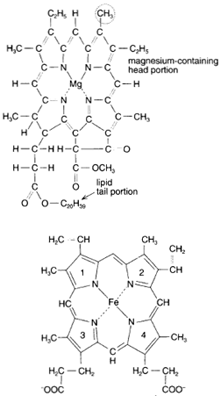Chlorophyll
 |
| Figure 9-7 Top: chlorophyll; bottom: hemoglobin |
A number of different kinds of chlorophyll have been discovered. All flowering plants have chlorophyll a and chlorophyll b, as well as the yellow pigments carotene and xanthophyll. The German chemist Richard Willstatter (1872-1942) determined the molecular structures of chlorophylls a and b and demonstrated that the yellow pigments carotene and xanthophyll are also present in green leaves. He reported that these four pigments are present in approximately the same relative proportions in all green plants. (Willstatter is said to have taken delight in undertaking the most complex chemical problems.)
Later studies revealed the existence of five different chlorophylls, twelve carotenes, and from seventy to eighty xanthophylls. Although the various chlorophylls differ only slightly in structure, only chlorophyll a is capable of directly catalyzing photosynthesis. Pigments other than chlorophyll a do absorb light; but if it is to be effective in photosynthesis, the energy absorbed by other pigments must be transferred to chlorophyll a.
It is remarkable to note that the molecular structure of hemoglobin, the red pigment of blood, is very similar to that of chlorophyll (figure 9-7). One significant difference, however, is found at the center of the molecules. Whereas chlorophyll has an atom of magnesium, hemoglobin has an atom of iron.




